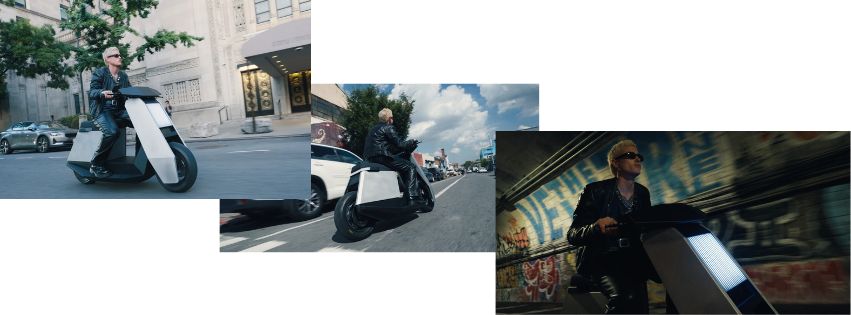At its core, modular mobility is about interchangeable components and attachable modules. One vehicle can shift from a nimble solo commuter to a family hauler, a shared fleet shuttle, or even part of a multi‑modal trip that ends above the city skyline. (Read more on low‑altitude mobility here.) It is not about one futuristic invention but an ecosystem designed to evolve with your needs.
Infinite Machine illustrates this idea beautifully. Their P1 scooter blends cyberpunk style with genuine practicality. You can clip on racks, speakers, or storage pods, or strip it back to its minimalist core. Hidden panels reveal hot‑swappable batteries. A central touchscreen integrates seamlessly with CarPlay and Android Auto, while front and rear cameras stream live visuals. Street‑legal models top out at 30 mph, but with the right license, you can unlock speeds up to 55 mph, showing that performance and practicality do not have to be opposites.
Its partner in this approach is the Olto e‑bike, with a 750 W motor and a 40‑mile range that quickly adapts from solo commuter to grocery getter once you click in a cargo rack or child seat. These rides are not merely transport; they are blank canvases you build on. Infinite Machine also goes beyond the vehicles themselves. Their online shop is filled with thoughtful accessories, from kid carriers and sleek Kryptonite locks to soft bags and even a custom metal backgammon set designed to fit perfectly into the bike’s compartments. This shows that modularity is not just a technical feature but a mindset that anticipates every way you might want to use your ride.
But modularity is not limited to Infinite Machine. India’s Ultraviolette Tesseract, though a high-performance scooter, reflects a modular mindset with different battery options and an emphasis on future‑proof electronics. While it does not feature attachable modules in the same way, its modularly scaled platform underpins multiple vehicle types, hinting at a flexible future.
Meanwhile, the UK’s Bo Turbo is a rocket on two wheels. Its dual 24,000 W powertrain aims for speeds over 100 mph, built with expertise from former Williams F1 engineers. It is far more of a performance statement than an urban commuter, but it proves that modular thinking is not just about adaptability. It can also mean pushing boundaries and redefining what a micro‑vehicle can be.
Then there is NEXT Modular Pods, being tested in Milan by Wayla for on‑demand micro‑transit. These three‑meter electric pods can link together or detach, reconfiguring on the fly for nine passengers or cargo loads depending on demand. It is modularity at the fleet scale, showing how shared vehicles can dynamically reshape themselves to meet urban needs.
What unites these innovations is the shift from static ownership to Mobility-as-a-Service. Vehicles adjust to the moment, share infrastructure, and reduce waste. Imagine an app that dispatches your P1 for the first mile, a near‑silent pod for the next stretch, or even an eVTOL for the last hop, all with a single tap. That is the emerging reality of seamless urban movement.

We are already seeing the foundations of urban air mobility take shape. eVTOLs with rooftop vertiports and even highway median landing pads are appearing in test programs across cities like Seoul. The global UAM market is projected to grow from $4.3 billion in 2024 to more than $5.2 billion in 2025, a fast‑arriving skyline for the next generation of commuting.
What matters most is that these platforms are not just transport. They are lifestyle enablers that reduce urban clutter, lower carbon footprints, and ease congestion while injecting choice, fun, and efficiency back into travel. A scooter that adapts to your life, pods that scale up for crowded commutes, and eVTOLs that bypass traffic altogether - it is a future built on modularity.
Infinite Machine illustrates how street‑level modular riding sets the template: a P1 for city errands, an Olto for family rides and cargo, all feeding into fleets and air links. It is a blueprint, not the blueprint, for how modular mobility can change the way we live and move.
As streets, pods, and even skies merge into one connected network, the real question becomes: which part of this modular future will you ride first?

Copyright Images & Video: https: infinitemachine.com

.webp)
.webp)
.webp)
.webp)
.webp)
.webp)
.webp)
